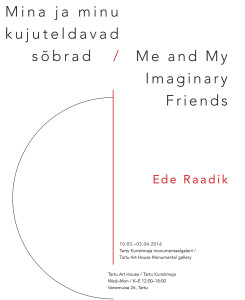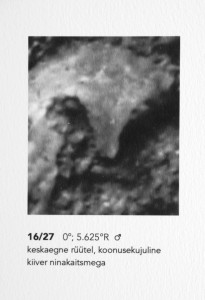Ede Raadik
Mina ja minu kujuteldavad sõbrad
10.03. – 03.04. 2016
Pareidoolia on inimaju kalduvus näha tähenduslikke kujundeid juhuslikes struktuurides, olles suurepäraseks aluseks süstemaatilisele pseudoteaduslikule mõttetusele. Sellest lähtuvalt olen kindla süsteemi järgi sihipäraselt vaadelnud ja kaardistanud põllukividel eri nurkade ja kallete all olevad „inimnäod”. Kõik leitud näod olen fikseerinud nii koordinaatide kui ka subjektiivsest kogemusest lähtuvate märksõnadega. Eesmärgiks vaadelda „enda sisse” viisil, mida tegi 19. sajandi astronoom Percival Lowell, kes kaardistas oma silma veresoonte varje, tõlgendades neid kaugete taevakehade pinnastruktuurina.
Protsess:
Märkisin põllul 1m2 maa-ala (sügavusega u 30cm). Esimesel vaatlusel võtsin kaasa 10 kivi.
Fikseerisin kindla vaate kividele, mille seejärel üles pildistasin. Määrasin vaadete keskkohad. Selle põhjal asetasin kivide tasapinnad ruudustikule, mille abil arvutasin pindalad. Lähtudes saadud tulemustest, otsustasin edasi tegeleda kividega suurusjärgus 100±10 cm2.
Lähtusin pindalade arvutamisel kasutatud ruudustikust ehk pindalast sõltub kaua kivilt nägusid otsin. Kehtib pindala-aja suhe 1cm2=30s.
————————————————-
Ede Raadik
“Me and My Imaginary Friends”
10.03. – 03.04. 2016
Opening venue Thursday 10.03. at 18:00
Pareidolia is the tendency of the human brain to detect meaningful images in random structures and as such is an excellent basis for systematic pseudo-scientific nonsense. Based on this idea I have systematically observed and mapped “human faces” that can be viewed in stones at different angles. All the faces I found I gave specific coordinates and labelled them with keywords based on my subjective experience. The aim is to “look inside myself” in a similar way to the 19th century astronomer Percival Lowell, who mapped the shadows of the blood vessels in his eyes, interpreting them as the surfaces of faraway structures in space.
Process:
I marked a 1m2 area (depth approx. 30 cm) in a field. For the first session I took 10 stones.
I fixed an angle of view onto the stone and then photographed it. I determined the centre points of the views. Based on that I placed the surfaces of the stones onto a grid I used to calculate the surface areas. Based on my results, I decided to work with stones that were 100±10 cm2.
I based my calculations for the surface area on the grid; in other words, the time I spent looking for faces on the surface depends on the size of the surface area. The relationship between the surface area and the time is 1cm2=30s.


